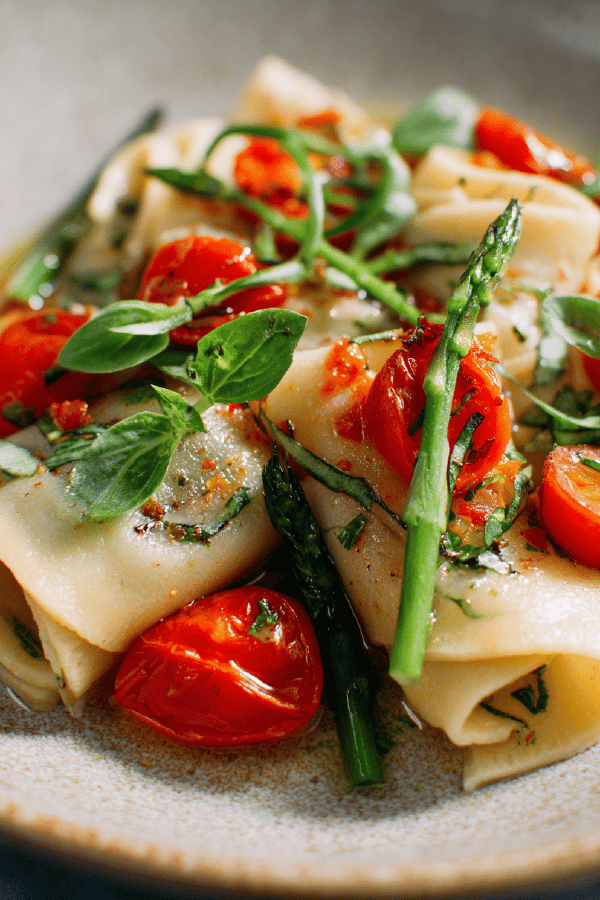Featured Recipe
Rustic Tomato Basil Pici

By Kate
"
A hand-rolled pasta merging fine semolina and spelt flour for robustness. Replaces water with hot vegetable broth for depth. Rolled into rough strands, then tossed with quick sautéed cherry tomatoes and fresh basil. Keeps firm bite with brief 7-minute cook. Finished with oil infusion and reserved pasta water for silkiness. Vegan, dairy-free, and nut-free.
"
Prep:
50 min
Cook:
7 min
Total:
57 min
Serves:
4 servings
Italian
pasta
vegan
rustic cooking
Introduction
Dough tricky? Keep it hot, keep it patient. Semolina gives that tooth, spelt adds a rustic nuttiness flavor-wise and texture-wise. Water swapped for broth adds faint umami. Rolling rough cuts? Perfect. No machines. No fuss. Roll with fingers, slight pressure, not crushing. Fresh pasta softens fast in boiling water. Cook long enough for tenderness but still firm—listen for tender bounce and flicker on surface. Toss in separately cooked tomatoes, bright fresh basil. That’s your twist—lightness and fresh punch. No dairy. No fuss. Simple pantry pantry pantry.
Ingredients
About the ingredients
Spelt flour works better here than plain all-purpose if you can get it—more chew, better flavor, holds shape under boiling. Semolina fineness is key; gritty semolina for dusting keeps pici strands separate without clumping. Vegetable broth warmer than plain water helps starter gluten activation and adds subtle aroma. Cherry tomatoes can be swapped with small plum tomatoes or even slow-roasted if you want sweetness concentrated. Basil optional but recommended for that herb burst. Olive oil is non-negotiable—finishes pasta and cooking tomatoes with a richness that balances acidity.
Method
Technique Tips
Mix dry first, then add hot broth carefully—too cold or too hot will change dough behavior. Knead until elastic but still soft; dough should be tacky but not sticky. Cut uniformly but don’t obsess about perfect bands—rustic means uneven size helps hold sauce differently. Rolling each strip smooth removes sharp edges that can tear during cooking. Pasta needs immediate semolina dusting or risk sticking—don’t skip this classic step. Cook pasta in plenty of boiling salted water; the pici will float up when nearly done; test by biting—should offer slight resistance, not mush. Save cooking water for sauce—starchy liquid binds flavors in pan. Tossing warm tomatoes rather than mixing cooked ingredients lets fresh herbs keep bright. Season last—always adjust salt at the end. Avoid overcooking tomatoes—they should burst but retain shape to contrast pasta texture.
Chef's Notes
- 💡 Keep pasta moist while rolling. Not too thick or too thin. If dough tears, gently patch it; glue it together with a pinch of water.
- 💡 Adjust water temperature. Non-steaming broth means less gluten activation. Keep it hot; improve elasticity for that coveted chew.
- 💡 Kneading matters greatly. Develop strength—remember, keep it firm. Use semolina during kneading if it gets too tacky. Check texture.
- 💡 Pasta sticking? Dust more semolina. Avoid flour; keeps strands separate. Transfer carefully onto trays. Let rest if making ahead.
- 💡 Tomatoes too juicy? Bake before sautéing. Concentrate sweetness; adds depth. Skip cooling after. Hot to hot, fresh herbs added last.
Kitchen Wisdom
How do I know when the pasta is done?
Watch it closely—pici should float. Test bite—should resist slightly but not hard.
Can I substitute the spelt flour?
Yes, all-purpose flour works fine, but lose some nuttiness in texture. Try durum for a firmer bite.
What if my tomatoes fall apart?
Don’t panic. Keep stirring—get those juices flowing. Can add a splash of broth to bind.
How to store leftover pasta?
Keep covered in fridge for two days at most. Reheat quickly in boiling water. Another option—freezing under semolina.



